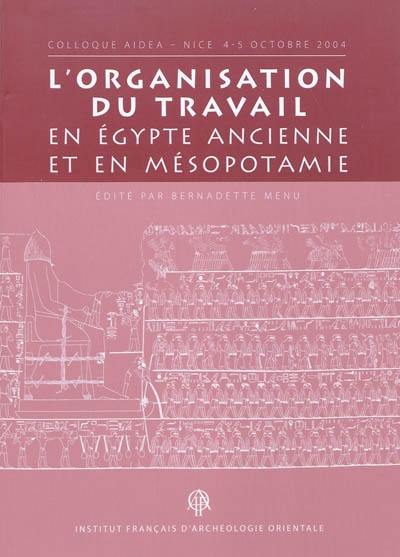
Fiche technique
Format : Broché
Nb de pages : 192 pages
Poids : 738 g
Dimensions : 20cm X 28cm
ISBN : 978-2-7247-0521-8
EAN : 9782724705218
L'organisation du travail en Egypte ancienne et en Mésopotamie
Quatrième de couverture
L'organisation du travail en Égypte ancienne et en Mésopotamie
La force de travail, extrêmement sollicitée au sein de sociétés antiques encore très peu mécanisées, fut organisée et gérée dans les grands empires proche-orientaux, tant au niveau central que dans ses implications locales et particulières.
Le colloque de l'Aidea consacré à l'organisation du travail en Égypte ancienne et en Mésopotamie (Nice, 2004) a réuni des spécialistes dont les contributions sont publiées dans le présent volume.
La construction des temples (Chr.J. Eyre), l'organisation des chantiers dans une province égyptienne excentrée (L. Pantalacci), le recrutement et l'enregistrement des ouvriers (B. Menu), le rôle des scribes (P. Piacentini), le statut des membres d'équipes de tisserands (Sch. Allam), le travail des artisans royaux à Deir al-Medina (R.J. Demarée), mais aussi la conception même du travail en Égypte à l'époque du Moyen Empire (K.A. Kóthay), le travail dans l'espace domestique et le travail des esclaves en Mésopotamie (S. Démare-Lafont ; Fr. Joannès), les contrats de travail à l'époque ptolémaïque et augustéenne (B. Anagnostou-Canas) constituent autant de chapitres solidement documentés qui font progresser d'une manière très notable nos connaissances sur le sujet et ouvrent des perspectives nouvelles.
Une introduction originale (R. Carvais), développant une approche comparative, permet de mettre en abyme les résultats obtenus, dans une « préhistoire du droit du travail » où l'on décèle quelques traces embryonnaires, mais incontestables, de droit du travail dans l'Antiquité proche-orientale.
In early mechanised societies of the ancient Near Eastern empires, centralised and decentralised organization and management of the workforces created its own individual implications.
The Aidea Colloquium (Nice 2004) brought together specialists that had the opportunity to devote themselves to subjects dealing with the organization of labour in Ancien Egypt and Mesopotamia. The contributions resulting from this colloquium are published in this volume.
The list of papers include : building of temples (Chr.J. Eyre) ; organization of building sites in an outlying Egyptian province (L. Pantalacci) ; recruitment and registering of workers (B. Menu) ; the role of scribes (P. Piacentini) ; status of members of weaver teams (Sch. Allam) ; work of the royal artisans at Deir al-Medina (R.J. Demarée) ; the conception of work in Egypt during the Middle Kingdom Period (K.A. Kóthay) ; work within the domestic sphere and the work of slaves in Mesopotamia (S. Démare-Lafont ; Fr. Joannès), as well as work contracts during the Ptolemaic and Augustean Periods (B. Anagnostou-Canas). Solidly documented chapters in this publication notably contribute to our knowledge of the subject and more importantly, bring new perspectives.
R. Carvais provides an original introduction in which he builds up a comparative approach, allowing a mise en abyme of the results obtained from this colloquium. Through this « prehistory or labour law », we may detect the embryonic, yet undeniable traces of labour law in the ancient Near East.





